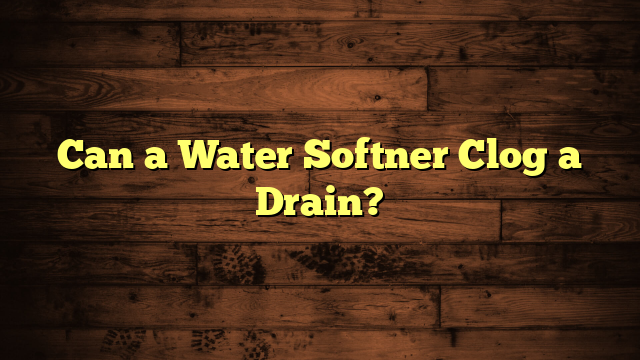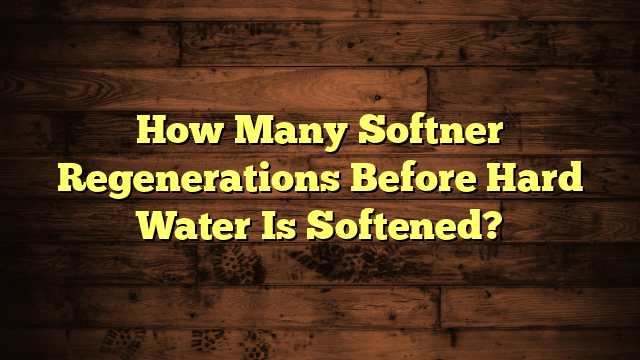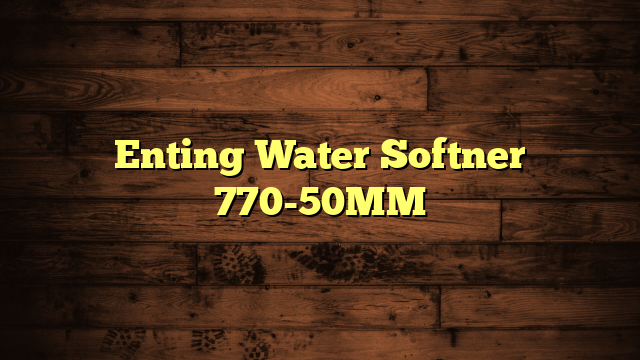Can a Water Softner Clog a Drain?
You might be surprised to learn that water softeners can actually contribute to drain clogs over time. When the softening process occurs, it produces brine, which can leave salt residue in your plumbing, leading to restricted flow and potential blockages. This accumulation not only affects the efficiency of your water softener but can also create an environment for harmful bacteria. So, how do you prevent these issues before they escalate into serious problems? Understanding the maintenance and operational nuances of your system can make all the difference.
Key Takeaways
- Water softeners can cause salt buildup in drains, leading to restricted flow and potential clogs.
- High salt levels may alter microbial environments, promoting harmful bacteria and resulting in unpleasant odors.
- Improper disposal of brine can violate regulations and contribute to drainage issues in plumbing systems.
- Regular maintenance, including flushing drain lines, helps prevent salt residue and blockages from water softeners.
- Signs of clogged drains, such as slow drainage and gurgling sounds, may indicate issues related to water softener use.
Understanding Water Softeners
When you think about improving your home's water quality, understanding water softeners is essential. Water softeners are devices designed to reduce the hardness of your water, which can greatly impact your plumbing systems. Hard water contains high levels of minerals, such as calcium and magnesium, that can lead to scale buildup in pipes, appliances, and fixtures.
By using a water softener, you exchange these hard minerals for sodium or potassium ions, making your water softer and more manageable. This process not only enhances your water quality, but it also extends the lifespan of your plumbing systems. Softer water can lead to improved efficiency in water heaters and dishwashers, reducing energy costs and preventing costly repairs.
Additionally, soft water can help your soaps and detergents work more effectively, leading to cleaner dishes and laundry. Incorporating a water softener into your home can be a game changer. You'll notice smoother skin after showering and shinier dishes after washing.
Ultimately, understanding water softeners can help you make informed decisions about your home's water quality and plumbing systems, ensuring a more comfortable living environment.
How Water Softeners Work
Water softeners work through a process called ion exchange, where hard water minerals like calcium and magnesium are swapped for sodium ions.
To facilitate this, they produce a brine solution, which is essential for maintaining the effectiveness of the resin beads inside the softener.
Understanding how these systems function, including their wastewater disposal methods, can help you better manage your home's water quality and prevent issues like drain clogging.
Ion Exchange Process
At the heart of a water softener's functionality lies the ion exchange process, a clever method for reducing hardness minerals like calcium and magnesium in your water. This process involves softening agents, typically sodium ions, which replace the hardness ions in your water as it flows through the softener's resin beads.
Here's a breakdown of how the ion exchange process works:
| Step | Action | Result |
|---|---|---|
| 1. Water enters | Hard water flows into the softener | Calcium and magnesium ions are present |
| 2. Ion exchange occurs | Sodium ions from resin swap places | Hardness minerals are removed |
| 3. Softened water exits | Water leaves the softener | You get soft water |
| 4. Cycle repeats | Process continues with the next batch | Consistent softening |
Through this ion exchange method, you not only enjoy softer water but also protect your plumbing from scale buildup. This improved water quality can enhance the effectiveness of soaps and detergents, making your daily chores easier. By understanding the ion exchange process, you can appreciate how crucial it is to your home's water system.
Brine Solution Production
Brine solution production is a significant step in maintaining the efficiency of your water softener. During this process, your system creates a concentrated saltwater solution, known as brine, which helps to cleanse the resin beads that trap hard minerals like calcium and magnesium.
You'll typically need to initiate this process manually or set it on a timer, depending on your water softener model.
Once the brine is produced, it's important to manage it properly. Some systems incorporate brine recycling, which allows the brine to be reused for the next regeneration cycle, reducing waste and improving efficiency.
However, when brine disposal becomes necessary, it's imperative to follow local regulations to avoid environmental harm. Improper disposal can lead to issues, including harming local waterways and groundwater.
Wastewater Disposal Methods
Efficient wastewater disposal is essential for the effective operation of water softeners. When you use a water softener, it produces brine, which must be disposed of properly to meet wastewater treatment standards. Understanding the methods of disposal can help you avoid clogs and comply with disposal regulations.
Here's a quick overview of common wastewater disposal methods for water softeners:
| Method | Description | Pros and Cons |
|---|---|---|
| Drain Disposal | Directly discharges brine into the sewer. | Simple and effective but may violate local regulations. |
| Septic Systems | Sends brine to a septic tank. | Requires special considerations to avoid system overload. |
| Evaporation Ponds | Allows brine to evaporate naturally. | Environmentally friendly, but requires space and time. |
Potential Drain Clogging Issues
When using a water softener, you mightn't realize that it can lead to potential drain clogging issues. The process of softening water typically involves the use of salt, which, when flushed down the drain, could contribute to buildup over time. If you're not careful, this buildup can lead to slow drainage or even complete blockages, requiring prompt drain cleaning.
Regular plumbing maintenance becomes essential to prevent these issues from escalating. You should keep an eye on your plumbing system, especially if you notice any signs of sluggish drains or unusual odors.
It's wise to schedule periodic inspections with a plumbing professional who understands the impact of a water softener on your drainage system. They can help identify any potential problems early on and recommend solutions to mitigate risks.
Additionally, consider using a drain filter or strainer to catch debris and prevent it from entering your pipes. This simple step can make a big difference in maintaining clear drains.
Salt Residue and Drain Problems
When you use a water softener, salt residue can build up in your plumbing, causing serious drainage issues.
This accumulation not only affects water flow but can also lead to costly repairs if left unchecked.
To keep your drainage system running smoothly, it's important to understand the impact of salt buildup and adopt preventive maintenance practices.
Salt Build-Up Issues
Have you ever noticed salty residue around your water softener or in your drains? This salt accumulation can lead to significant issues over time. If you don't address it, the salt can harden and create blockages in your plumbing system.
You might find that these deposits not only clog your drains but also contribute to pipe corrosion. When salt builds up, it interacts with both the water and the metal in your pipes, accelerating deterioration. This can lead to leaks and costly repairs down the line.
You may even notice a decline in your water flow, which could be a sign that something's amiss in your plumbing. To avoid these problems, regularly inspect your water softener and clean any visible salt residue.
Flushing your system can help, too. You want to guarantee that salt doesn't linger in your pipes longer than necessary. By being proactive about salt build-up, you can maintain your plumbing's health and extend its lifespan.
Keeping an eye on these issues will save you time, money, and headaches in the future.
Drainage System Impact
Salt residue not only affects your water softener but also greatly impacts your drainage system. When salt builds up in your plumbing, it can lead to several issues that compromise both the drainage system design and plumbing material compatibility.
Here are some ways salt residue can create problems:
- Clogging: Salt can accumulate in pipes, leading to blockages that restrict water flow.
- Corrosion: Certain plumbing materials mightn't be compatible with salt, resulting in faster deterioration over time.
- Bacterial Growth: High salt levels can alter the microbial environment in your drains, encouraging harmful bacteria growth.
- Water Quality: An overloaded drainage system may lead to unpleasant odors and even backflow issues, affecting your home's overall water quality.
Being aware of these potential impacts helps you maintain your plumbing effectively.
Regularly check your drainage system for signs of salt buildup and consult professionals if you notice issues.
By addressing problems early, you can guarantee your water softener works efficiently without harming your drainage system.
Taking these proactive steps will save you time, money, and headaches down the road.
Preventive Maintenance Tips
Regular maintenance of your water softener and drainage system can prevent salt residue issues before they start. To keep your system running smoothly, make preventive maintenance a priority.
Begin with regular checks of your water softener's salt levels. Ideally, you should refill the salt when it drops below half full. This helps guarantee that your system operates efficiently, minimizing the risk of salt buildup in your drains.
Next, inspect any drain lines for signs of salt residue or blockages. If you notice a white crust forming, that's a clear indication of salt accumulation. Cleaning these areas regularly can save you from future headaches.
Furthermore, consider flushing your drainage system periodically to clear out any mineral deposits or buildup.
Lastly, don't forget to check your water softener's brine tank. A clogged brine line can lead to poor performance and salt residue issues.
Other Contributing Factors
While water softeners are commonly blamed for drain clogs, several other contributing factors can play a significant role. Understanding these factors is essential for effective plumbing maintenance and addressing drainage issues.
- Pipe Build-Up: Over time, grease, hair, and soap scum can accumulate in your pipes, leading to clogs that may be mistaken for water softener-related problems.
- Improper Installation: If your water softener isn't installed correctly, it might disrupt the natural flow of water, affecting your drainage system.
- Old or Damaged Pipes: Aging or damaged pipes can develop cracks or collapses that impede water flow, causing drainage issues that seem linked to the water softener.
- Tree Roots: Roots from nearby trees can infiltrate your plumbing system, leading to blockages and drainage issues that have nothing to do with your water softener.
Maintenance Tips for Water Softeners
To keep your water softener running efficiently, it's crucial to perform regular maintenance.
Start by checking the salt level in the brine tank at least once a month. A low salt level can compromise system efficiency and affect your water quality. When you notice the salt dropping below the recommended level, refill it with high-quality salt specifically designed for water softeners.
Next, inspect the resin beads in the tank. Over time, these beads can become less effective, so consider replacing them every 5-10 years.
Regularly cleaning the brine tank is equally important; aim to do this at least once a year to prevent sludge buildup, which can hinder performance.
Don't forget to monitor your system's settings. Verify that the regeneration cycle is adjusted based on your water usage and hardness level. This helps maintain peak system efficiency and prolongs the life of your water softener.
Lastly, keep an eye on the filter screens and clean them as needed.
Signs of Clogged Drains
After verifying your water softener is properly maintained, it's important to be aware of the signs of clogged drains. Recognizing these signs early can help you avoid more significant plumbing issues later.
Here are some key indicators that your drains might need inspection:
- Slow Draining Water: If water takes longer than usual to drain, it could indicate a buildup or obstruction in the pipes.
- Unpleasant Odors: Foul smells emanating from your drains often signal decomposing food or other debris stuck within the plumbing.
- Gurgling Sounds: If you hear gurgling noises when using your sink or toilet, it's a sign that air is trapped and that drainage isn't functioning correctly.
- Frequent Backups: If you find yourself frequently having to clear blockages, it suggests a more persistent clog that needs to be addressed.
Regular drain inspections can help you stay on top of these issues and assist in clog prevention.
By being proactive, you can maintain smooth drainage and guarantee your plumbing system runs efficiently.
Stay vigilant, and address these symptoms promptly to avoid bigger problems down the road.
Solutions to Prevent Clogs
Preventing clogs in your drains is essential for maintaining a healthy plumbing system. You can take several effective steps for clog prevention that will keep your drainage solutions running smoothly.
First, consider installing a drain screen or strainer to catch hair, food particles, and other debris before they enter your pipes. This simple addition can make a significant difference.
Next, regularly flush your drains with hot water. Doing this once a week helps dissolve soap scum and grease buildup, keeping your pipes clear. You might also want to try a mixture of vinegar and baking soda once a month. This natural remedy can break down minor clogs and freshen your drains without harsh chemicals.
Additionally, be mindful of what you put down your drains. Avoid pouring fats, oils, and grease, as these can solidify and cause blockages.
Finally, consider a professional plumbing inspection every couple of years. This proactive measure can identify potential issues before they turn into major problems.
Frequently Asked Questions
Can a Water Softener Impact My Home's Plumbing System?
Yes, a water softener can impact your home's plumbing system. It improves water quality but may require regular plumbing maintenance to prevent buildup. Make certain you check connections and clean filters to maintain smooth operation.
How Often Should I Check for Drain Clogs?
You should check for drain clogs regularly, ideally every few months. Consistent drain maintenance helps you spot issues early, ensuring clog prevention and keeping your plumbing system flowing smoothly without unexpected backups or repairs.
Are There Specific Brands of Water Softeners Less Likely to Clog Drains?
When it comes to brand recommendations, look for water softeners designed with clog prevention in mind. Models from brands like Culligan and Fleck often provide reliable performance, minimizing the risk of unexpected plumbing issues.
Can I Install a Water Softener Myself?
Yes, you can install a water softener yourself with some DIY installation skills. Follow installation tips carefully, ensuring proper connections and settings. Just make sure to read the manual and gather necessary tools before starting.
What Is the Average Lifespan of a Water Softener?
Like a trusty steed, your water softener's lifespan can vary. With diligent water softener maintenance and attention to lifespan factors like usage and quality, you can enjoy its service for 10 to 15 years or more.
Conclusion
To summarize, while water softeners provide many benefits, they can indeed clog drains due to salt buildup. Notably, about 10% of households with water softeners experience drainage issues related to this. Regular maintenance is key to preventing these problems and ensuring your system runs smoothly. By staying vigilant and addressing any signs of clogs early, you can enjoy the advantages of softened water without the hassle of plumbing headaches.







